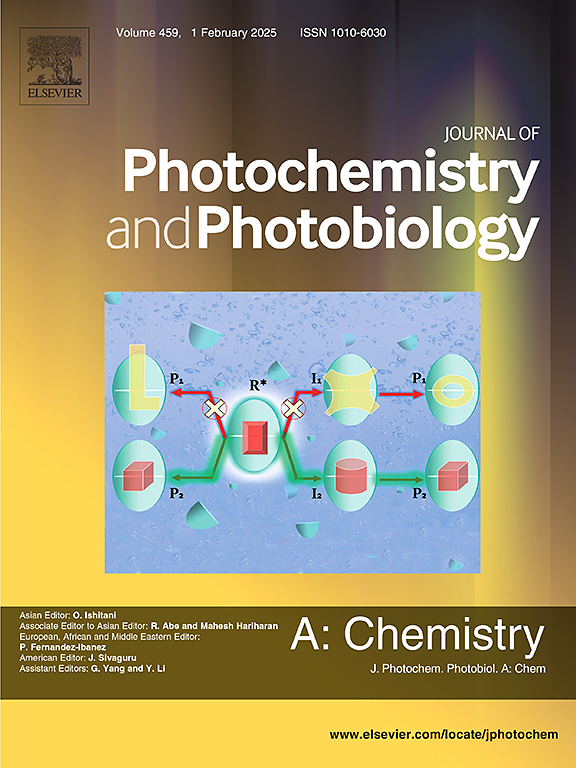Adopted green spectrophotometric determination of futibatinib based on diazo coupling with 1-naphthol and assisted computational calculations
IF 4.1
3区 化学
Q2 CHEMISTRY, PHYSICAL
Journal of Photochemistry and Photobiology A-chemistry
Pub Date : 2025-03-24
DOI:10.1016/j.jphotochem.2025.116396
引用次数: 0
Abstract
Futibatinib, a potent fibroblast growth factor receptor inhibitor, received US approval on September 30, 2022, for treating breast, esophageal, and lung cancers by reducing cell viability. A new spectrophotometric method has been developed to accurately quantify this drug with the use of computational tools and matching environmentally friendly (green) principles. 1-Naphthol was found to be the best reagent for diazo-coupling of futibatinib based on the density functional theory calculations. The experimental process involves diazo coupling futibatinib with sodium nitrite to produce a diazonium ion, which then interacts with 1-Naphthol to develop a red-colored chromogen complex. At 514 nm, the resultant complex displays defined measurable quantitative absorption peaks. A number of elements that affect the diazotization were researched in order to optimize the process. The method exhibited excellent linearity within the range of 1–12 μg/mL (r2 = 0.9996), with limits of detection and quantification at 0.10 μg/mL and 0.30 μg/mL, respectively. It also demonstrated high accuracy (99.32 %) and precision (%RSD < 1). The proposed method has a greener profile, scoring 0.69 compared to 0.48 for previously reported UPLC-MS/MS methods, offering reduced waste, shorter analysis times, and lower energy consumption. Additionally, it is more cost-effective and environmentally sustainable, making it a viable choice for both pure and pharmaceutical applications.

采用重氮与1-萘酚偶联的绿色分光光度法测定福替替尼,并辅助计算
Futibatinib是一种有效的成纤维细胞生长因子受体抑制剂,于2022年9月30日获得美国批准,用于通过降低细胞活力来治疗乳腺癌、食管癌和肺癌。一种新的分光光度法已经被开发出来,使用计算工具和匹配环境友好(绿色)原则来准确地定量这种药物。通过密度泛函理论计算,发现1-萘酚是福替替尼重氮偶联的最佳试剂。实验过程涉及重氮偶联福替替尼与亚硝酸钠产生重氮离子,然后与1-萘酚相互作用产生红色的显色复合物。在514 nm处,合成的复合物显示出确定的可测量的定量吸收峰。为了优化工艺,研究了影响重氮化的因素。该方法在1 ~ 12 μg/mL范围内呈良好的线性关系(r2 = 0.9996),检测限为0.10 μg/mL,定量限为0.30 μg/mL。准确度(99.32%)和精密度(%RSD <;1).与之前报道的UPLC-MS/MS方法的0.48相比,所提出的方法具有更环保的特征,得分为0.69,减少了浪费,缩短了分析时间,降低了能耗。此外,它更具成本效益和环境可持续性,使其成为纯和制药应用的可行选择。
本文章由计算机程序翻译,如有差异,请以英文原文为准。
求助全文
约1分钟内获得全文
求助全文
来源期刊
CiteScore
7.90
自引率
7.00%
发文量
580
审稿时长
48 days
期刊介绍:
JPPA publishes the results of fundamental studies on all aspects of chemical phenomena induced by interactions between light and molecules/matter of all kinds.
All systems capable of being described at the molecular or integrated multimolecular level are appropriate for the journal. This includes all molecular chemical species as well as biomolecular, supramolecular, polymer and other macromolecular systems, as well as solid state photochemistry. In addition, the journal publishes studies of semiconductor and other photoactive organic and inorganic materials, photocatalysis (organic, inorganic, supramolecular and superconductor).
The scope includes condensed and gas phase photochemistry, as well as synchrotron radiation chemistry. A broad range of processes and techniques in photochemistry are covered such as light induced energy, electron and proton transfer; nonlinear photochemical behavior; mechanistic investigation of photochemical reactions and identification of the products of photochemical reactions; quantum yield determinations and measurements of rate constants for primary and secondary photochemical processes; steady-state and time-resolved emission, ultrafast spectroscopic methods, single molecule spectroscopy, time resolved X-ray diffraction, luminescence microscopy, and scattering spectroscopy applied to photochemistry. Papers in emerging and applied areas such as luminescent sensors, electroluminescence, solar energy conversion, atmospheric photochemistry, environmental remediation, and related photocatalytic chemistry are also welcome.

 求助内容:
求助内容: 应助结果提醒方式:
应助结果提醒方式:


